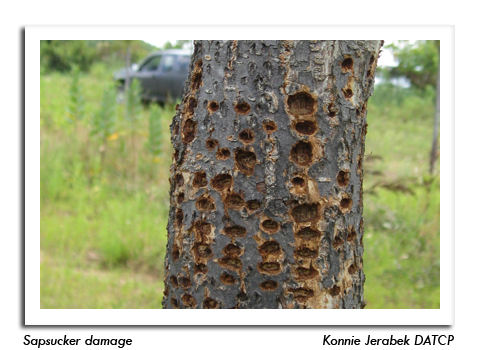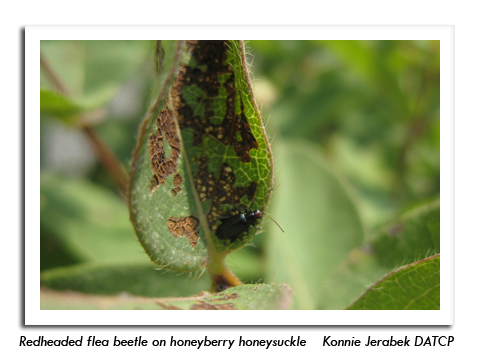
 |
|
|
Nursery & Forest
Volume 59 Number 14 Date 08/07/2014 VERTICILLIUM WILT - Catalpa, redbud and sugar maple trees at a nursery in Walworth County were diagnosed with this fatal vascular disease, frequently misidentified as decline caused by environmental factors. Symptoms are highly variable and may be acute or chronic. Acute symptoms include premature fall coloration, wilting, defoliation, branch dieback and death, whereas chronic symptoms typically reflect damage from earlier infections and may include slow growth, sparse foliage, stunted leaves and twigs, leaf scorch and abnormally heavy seed crops. Trees showing severe wilt and dieback cannot be saved, although regular watering during dry periods may reduce symptom severity. Verticillium-infected plants should be replaced with a non-host species such as aspen, beech, sycamore, poplar, willow or any conifer. LINDEN BORER - An unmistakable sign of linden borer infestation, namely sawdust-like frass exuding from the trunks and collecting at the bases of trees, was noted on several 'Greenspire' lindens trees in St. Croix County. The frass is a by-product of larval feeding in the sapwood. This destructive wood-boring insect attacks both vigorous and stressed nursery trees, causing structural weakening that often results in broken trunks or limbs, rapid decline and death. Early symptoms include thinning of the canopy and bark cracks or bulges where feeding has taken place Larger trees may not show symptoms for 2-5 years, while smaller trees may exhibit symptoms the year they are infested. Dead or dying trees contain many borer larvae and should be cut down and burned or chipped before adults emerge in summer.. YELLOW-BELLIED SAPSUCKER - This member of the woodpecker family was the cause of moderate-to-severe damage to various crabapple and elm trees at nurseries in Shawano and St. Croix counties. Sapsuckers peck holes in trees and larger woody shrubs, feeding on the bark, sap and insects drawn to the sap. Their holes generally are not harmful, but some smaller or less vigorous trees and shrubs may be killed if damage is extensive enough to girdle the trunk or stem. In rare instances, the damage can render trees unfit for sale. JAPANESE BEETLE - Nursery inspectors found minor feeding damage to apple, elm, linden, serviceberry, willow and many other ornamentals this week in Brown, Kenosha and Walworth counties. Adults of this species skeletonize foliage, leaving only the network of veins, while the subterranean grubs feed on roots of grasses and frequently damage turf in lawns, parks and golf courses. Of the range of control measures that may be directed against the adult or larval stages (i.e. trapping, insecticides, milky spore disease, insect parasitic nematodes, etc.), none is as effective as physically removing the adults from plants in the early morning or late evening hours, when they are less active. The beetles may be killed using a bucket of soapy water or by placing them in a plastic bag and freezing the contents for 72 hours. -- Ellen Hermanson, DATCP Nursery Inspector HOSTA ANTHRACNOSE - The dark lesions observed on the stems and leaves of assorted hosta plants at a nursery dealer in Polk County were diagnosed as hosta anthracnose, the most common foliar disease affecting hostas. This fungal disorder thrives in warm, wet settings and can be controlled by keeping foliage dry. Removing infected leaves, maintaining adequate plant spacing, and disinfecting pruning tools between cuts are also recommended. This anthracnose fungus is a different species the one that infects oaks and other shade trees in spring. CYTOSPORA CANKER - Colorado blue spruce trees in a St. Croix County nursery field were exhibiting oozing cankers and dieback of the lower branches associated with this fungal disease. The canker-causing fungi invade the bark of twigs, branches or trunks of woody plants that are physiologically stressed due to drought, flooding, insects or mechanical injury. Diseased branches should be pruned out during periods of dry weather, while cankers that develop on the trunk require removal and destruction of the entire tree. Many other trees are susceptible to this disorder, including apple, ash, aspen, birch, cottonwood, elm, maple, poplar and willow. Cytospora canker is more common on trees over 15 years old, but may occur on younger trees. REDHEADED FLEA BEETLE - These shiny black beetles with prominent reddish heads were abundant on the leaves of several containers of ornamental shrubs and perennials at a nursery dealer in Polk County. According to the inspector's report, a few honeyberry honeysuckle plants were severely damaged. The beetles were also noted on hydrangea, rudbeckia, salvia and weigela. Defoliation caused by flea beetle feeding varies by leaf type, appearing as skeletonizing or shredding on thinner leaves and a linear, leafminer-like pattern on the thicker, fleshy leaves of sedum and similar plants. The source of the nursery infestation may have been nearby corn and soybean fields where crop surveys have observed locally heavy beetle populations in the last two weeks. It is unlikely that the beetles emerged from container media. Insecticides directed against the adults are the most effective control, but repeat application is often required. -- Konnie Jerabek, DATCP Nursery Inspector 





|
|
|